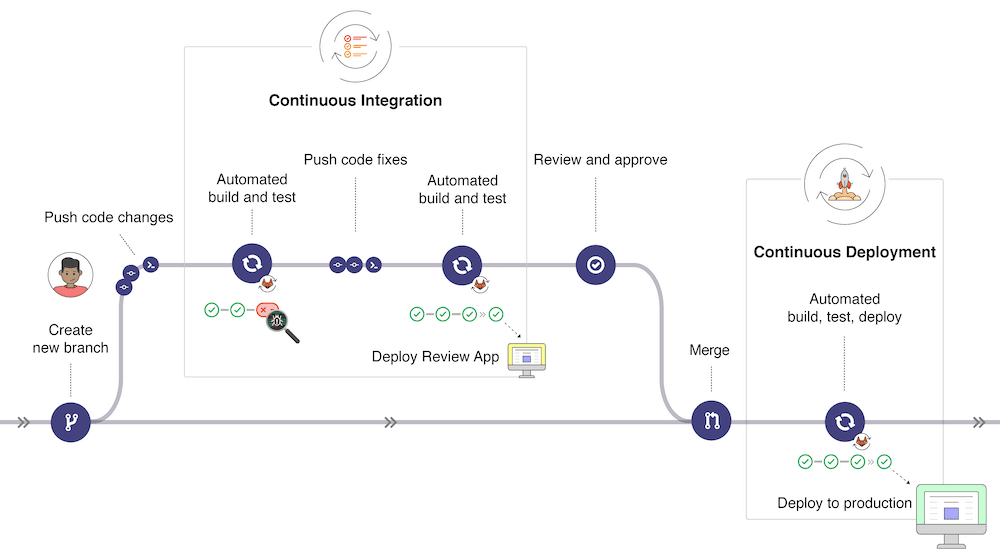
Build CI/CD Pipeline for Embedded Software

CI/CD pipeline as a part of DevOps (Development Operations) is a relatively innovative concept. In essence, it is a set of practices and methods to improve software development and operation processes’ efficiency through continuous integration and the active introduction of automation.
DevOps is an Agile-derived approach directed at eliminating organizational and time barriers between development teams and other software life cycle participants. The main goal here is to publish the intermediate software releases faster and more reliably while upholding the highest possible quality and improving the cooperation between departments. It also speeds up the team workflow through end-to-end task automation. One of the central techniques in today’s DevOps is CI/CD (continuous integration, continuous delivery). In addition, our cloud development services play a pivotal role, offering scalable and efficient solutions to enhance your project’s infrastructure and operational capabilities.
Even if rather specific, the emerging industry of software development for embedded systems still obeys general laws and trends. Due to the specifics, this area benefits the most from the implementation of DevOps methods and principles – from the resulting increase in the level of integration and communication between hardware and software specialists. Those minor differences that should be kept in mind will be mentioned in this CI/CD tutorial’s relevant sections.
CI/CD Pipeline: Definition
CI/CD is technology-focused at providing end-to-end automation of building, testing, and deploying the code.
Continuous integration simplifies the process of introducing new code into the existing. Continuous delivery starts where continuous integration ends. It automates the app deployment to different environments: specialists from various departments work together with production, development, and test environments.
Thus, CI/CD pipeline allows to test a software at every development stage with minimal resource costs and almost instantly runs the updated code.
Below we will discuss the relevance of DevOps techniques and present a comparison of useful DevOps tools (like GoCD vs Jenkins), employed and tested in our team’s personal CI/CD experience.
Main DevOps Pipeline Stages
From our expertise, we can differentiate the five significant stages to the CI/CD process that we are going to describe in this CI/CD tutorial:
- Committing the source to the repository;
- Building the intermediate release;
- Conducting the smoke testing;
- Conducting the functional testing;
- Deploying the current release automatically.
When using such CI/CD pipeline tools the modern versioning systems like Github, specific release run would look like this:
- Forking the code from the primary branch;
- Applying changes into the forked code;
- Starting the continuous integration process:
- Iterating the sequence of automated building, automated testing, and altering the forked code (if bugs are discovered in automated testing);
- Conducting the manual testing and approval processes;
- Steps 3 and 4 can be repeated as much as needed until the code is approved;
- Merging the forked code back into the primary branch;
- Starting the continuous deployment process:
- Iterating the sequence of automated building, testing, and deploying over all of the assumed platforms.
You can see an example pipeline according to GitLab in the picture below:

CI/CD Pipeline: When Is It Needed?
CI/CD pipeline can be used in conjunction with any of the existing Agile approaches. In particular, CI/CD automation of testing provides the fastest possible coordination between the teams that work on the project.
This technique is ideal for any task where new software development is underway, especially in projects based on microservice architecture.
On the other hand, the DevOps pipeline is not suitable for adjusting monolithic IT systems created according to the traditional Waterfall methodology since every intermediate release would require remaking the program’s entire architecture.
Below we provide a short and straightforward CI/CD tutorial together with GoCD vs Jenkins comparative.
How to Create DevOps Pipeline Architecture?
Let us look at the CI/CD best practices that Sirin Software uses in its personal CI/CD experience.
Introduce a version control management solution
The version control system allows accounting for the most minor changes to the code without rebuilding the application from the grounds up every time, thus simplifying the CI/CD pipeline. Such systems help to avoid confusion in code branches when several teams work together by forming a central repository with a clear structure. Simultaneously, you can merge project branches and leave comments without the possibility that the changes stay unnoticed by other teams.
There are two types of version control systems for CI/CD pipeline, decentralized and client-server. The most popular today are the decentralized Git-based systems.
Establish the Workflow
There are two main pieces of advice here:
- Track the issues. All the staff members should understand the specific issues within each separate branch of code and freely offer their advice if there is something they can help with. There are several instruments for this like Jira or IBM Rational ClearQuest;
- Manage the task distribution. The critical though often-overlooked problem in collectives with a wide variety of experts is tracking and managing tasks. The three most often used services for task management are ClickUp, Trello, and Basecamp.
Finally, you should have an established strategy for merging the branch code with the master source. There are some funny stories on the Internet of how the whole teams were dismissed when someone on a problematic branch forced a pull request. These stop being entertaining the moment something similar happens in the project you work on. Elusive bugs introduced due to mismanagement of pull requests may persist for years.
Choose the CI/CD pipeline tools
To deploy the DevOps approach, you need baseline software such as Jenkins, an open-source Java-based automation server solution. CI/CD tools Jenkins It allows integrating all kinds of development lifecycle processes such as building, testing, applying patches, deploying, etc., using addons. To establish an uninterrupted Jenkins CI/CD pipeline, more than 1000 existing tools can be used. For instance, Maven for building/reporting/documenting, SE for continuous testing, Git for version controlling, Puppet for configuration management, etc.
GoCD vs Jenkins
One of the most often mentioned alternatives to CI/CD tools Jenkins is GoCD. This high-performance continuous delivery platform provides CI/CD automation for testing and release processes.
GoCD pipeline is viral among smaller startups. This can be explained by its philosophy – maximum functionality in a single solution. On the other hand, the GoCD pipeline service has quite a high entry threshold due to many operators/commands and complex configuration and requires trained experts for further maintenance. Also, some GoCD users complain about a poor interface and the need to configure agents for scaling.
Jenkins, in turn, is so simple that it can be set up and maintained by personnel without high technical knowledge. Its features allow using it as a base for comprehensive end-to-end automation of the development process, scaling and extending on the go when the need arises. Today Jenkins is used by NASA, Nintendo, and other large organizations. However, more than 35% of users account for smaller teams of up to fifty people.
Connect building automation tools
CI/CD pipeline tools such as:
- Maven;
- Grunt;
- Rake;
- SCons;
- Cake;
- ASDF;
- Cabal, help in automating the process of code converting, simplifying the processes of testing, and CI/CD Jenkins software deployment in multiple environments at once.
Establish the automated testing routines
This step of the CI/CD process includes covering the built program code with automated testing. This allows eliminating the basic risks associated with the human factor, such as incorrect syntax, thus reducing time costs.
In particular, you can use one of the following popular CI/CD pipeline tools:
- JUnit;
- Pytest;
- Cobertura;
- Coverage.py;
- Jasmine, etc.
Following the above steps, you can create the basic infrastructure for the successful CI/CD pipeline. Nevertheless, it would have little to no capabilities for scalability given the rising load. This is where software containers and orchestrators come to the aid.
What is a Containerized App?
With the development of the concept of virtualization and the growth of its possibilities, the idea of a containerized application appeared. Containerization assumes packing an application and the environment it requires into a fully standardized container that connects to the host or external systems using specific interfaces. Such a self-contained virtual machine is independent of the resources or architecture of the host it runs on.
All components required to run the application are packaged as a single image and can be reused. The containerized application runs in an isolated environment and does not directly use the host operating system’s resources. This ensures that the processes inside the container are isolated, which increases its resiliency and efficiency.
One of the first and most successful companies to develop container virtualization solutions was Docker Inc., which released Docker in 2013. Their products are considered the benchmark, occupy about 25% of the market, and are widely used in the software development industry.
Using containers in the CI/CD Jenkins infrastructure, you can run multiple instances of the same app and assign a separate task to each or distribute the load between them. Thus, you get an application that can automatically increase or decrease its performance depending on your needs. This is what container application orchestrators like Kubernetes do.
The Role of Containerized App Orchestrators in Establishing a CI/CD Pipeline
Now let us talk discuss the role of Kubernetes in the CI/CD process. Kubernetes is an open-source orchestration platform for container services and workloads widely employed in end-to-end CI/CD automation.
he main advantages of using Kubernetes and Docker for the CI/CD process are automated deployment and scaling, host isolation, and remote configuration capabilities using the command-line interface (CLI) or dashboard. Moreover, you can orchestrate not only the deployment of developed products but elements of CI/CD Jenkins infrastructure too.
In addition to Kubernetes and Dockers, you can use middleware automation tools to make it easier to install and manage configurations, both for developed app and CI/CD pipeline tools themselves. Most popular in this niche are Ansible, Puppet, and Chef.
As for Ansible, it is worth using in the Jenkins CI/CD pipeline due to its flexibility and the ability to simplify the handling of complex cases. Ansible comes with ready-to-use modules and roles.
Would You like to Implement DevOps Pipeline in Your Project?
We hope this article helped you understand the need to implement the CI/CD pipeline. Our brief CI/CD tutorial also mentioned the most popular tools like Jenkins or GoCD and CI/CD best practices that you can use during your deployment process.
If you need a team of experts to implement the CI/CD pipeline, just contact us at Sirin Software. Our team includes top specialists with the broadest practical CI/CD experience, so you are guaranteed to be satisfied with our services of Jenkins CI/CD pipeline implementation.
To get more info about our projects, in which we employ CI/CD pipeline extensively, visit our blog and portfolio.



